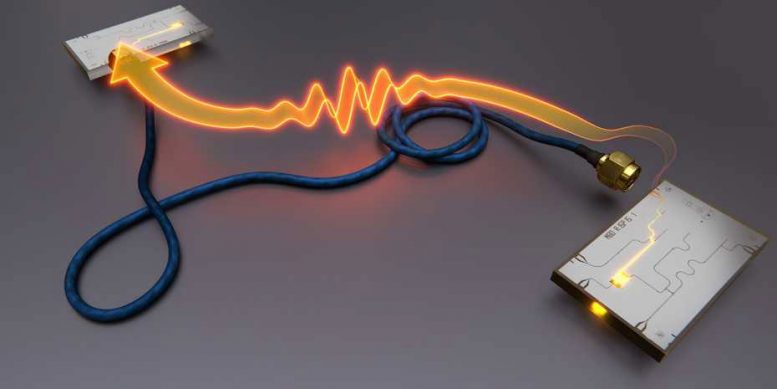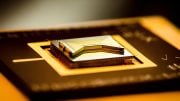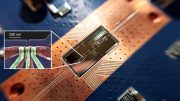
For the first time, the quantum state of a superconducting qubit was transferred with a coaxial cable to another qubit. Credit: ETH Zurich /M. Pechal, T. Walter, P. Kurpiers
In the new quantum information technologies, fragile quantum states have to be transferred between distant quantum bits. Researchers at ETH have now realized such a quantum transmission between two solid-state qubits at the push of a button.
Data transmission is the backbone of the modern information society, on both the large and small scale. On the internet, data are exchanged between computers all over the world, most often using fiber optic cables. Inside a computer, on the other hand, information has to be shuttled back and forth between different processors. A reliable exchange of data is also of great importance for the new quantum information technologies that are currently being developed – but at the same time it is also fiendishly difficult. At the ETH in Zurich, a team of physicists led by Andreas Wallraff of the Laboratory for Solid State Physics has now succeeded in transmitting quantum information, at the push of button and with high fidelity, between two quantum bits roughly a meter apart. Their results are published in the scientific journal Nature this week.
Flying quantum bits
The main peculiarity of quantum information technologies, such as quantum computers and quantum cryptography, is the use of quantum bits or «qubits» as the elementary unit of information. Differently from classical bits, qubits cannot just have the value 0 or 1, but also take on so-called superposition states. On the one hand, this results in the possibility to build extremely powerful computers that make use of those superposition states to perform calculations much more efficiently and faster than classical computers. On the other hand, those states are also very sensitive and cannot be transmitted simply using conventional techniques. The problem is that the state of a stationary qubit first has to be transformed into a so-called “flying” qubit, for instance, a photon, and then back into another stationary qubit. A few years ago researchers were able to transmit the quantum state of an atom in this way. Wallraff and his co-workers have now succeeded in realizing such a transmission also from one superconducting solid-state qubit to another one some distance away.
To do so, the physicists connected two superconducting qubits using a coaxial cable of the kind that is also used to connect to antenna terminals. The quantum state of the first qubit, which is defined by the number of superconducting electron pairs (also known as Cooper pairs) contained in it, was first transferred to a microwave photon of a resonator using very precisely controlled microwave pulses. From that resonator, the photon could then fly through the coaxial cable to a second resonator, inside of which microwave pulses, once more, transferred its quantum state onto the second qubit. Similar experiments were recently carried out at Yale University.
Deterministic rather than probabilistic
“The important point of our method is that the transmission of the quantum state is deterministic, which means that it works at the push of a button,” Philipp Kurpiers, a Ph.D. student in Wallraff’s lab, emphasizes. In some earlier experiments a transfer of quantum states could already be realized, but that transmission was probabilistic: sometimes it worked, but most of the time it didn’t. A successful transmission could, for instance, be signaled by a “heralding photon.” Whenever the transmission hadn’t worked, one simply tried again. In that way, the effective quantum transmission rate was, of course, strongly reduced. For practical applications, therefore, deterministic methods such as the one now demonstrated at ETH are clearly advantageous.
“Our transmission rate for quantum states is among the highest ever realized, and at 80% our transmission fidelity is very good in the first realization of the protocol,” says Andreas Wallraff. Using their technique, the researchers were also able to create a quantum mechanical entanglement between the qubits as many as 50,000 times per second. The transmission procedure itself took less than a millionth of a second, which means that there is quite a bit of room for improvement in the transmission rate. Quantum mechanical entanglement creates an intimate link between two quantum objects even across large distances, a feature that is used for cryptography or quantum teleportation.
Quantum transfer for quantum computers
As a next step, the researchers want to try to use two qubits each as transmitter and receiver, which makes entanglement swapping between the qubit pairs possible. Such a process is useful for larger quantum computers, which are supposed to be built in the next few years. So far, they only consist of a handful of qubits, but when trying to build larger computers, already for a few hundred qubits one will have to worry about how to connect them most effectively in order to exploit the advantages of a quantum computer in the best possible way.
Much like clusters of single computers used today, quantum computer modules could then be connected together using Wallraff’s technique. The transmission distance, which is currently about a meter, could certainly be increased. Wallraff and his colleagues recently demonstrated that an extremely cold, and thus superconducting, cable could transmit photons over distances of several tens of meters with very little loss. Wiring together a quantum computing center, therefore, seems to be quite feasible.
Reference: “Deterministic quantum state transfer and remote entanglement using microwave photons” by Kurpiers P, Magnard P, Walter T, Royer B, Pechal M, Heinsoo J, Salathé Y, Akin A, Storz S, Besse J-C, Gasparinetti S, Blais B, Wallraff A, 13 June 2018, Nature.
DOI: 10.1038/s41586-018-0195-y








I least this article doesn’t mention the ridiculous idea of data transmission speed faster than light. That is not allowed under Special Relativity whether by probabilistic or deterministic quantum transmission. The only way around that would be to warp space-time. Even though the method has be mathematically verified as consistent with GR, it requires exotic states of energy no one has any idea how to create. The estimated time frame, if ever, is 1000 years. So stick around and see. Right.
wats amm i gunna duu wid dis information eeeeh
first in areas of this kind of science there must be a more advanced vocabulary capable of communicating sets of data points outside of human conception! information from different dimensions? how do you communicate with entities you can not see but know their there? solve this problem first then solve the quantum transmission state over different medias? media, copper wires any wires? air, water, dirt, rock, space? how can a man build a device that will communicate with other points on a vine? is the brain the key to this task? how does a neuron work within the brain ? how do electrons work within a energy cloud? how do cells work within a tissue? how do farmers work within a farm? how do bankers work with in bank? how do doctors work within a operating room? all of these questions have answers! if i can think of a system that sends info over a media and if anyone tried to intercept this single the transmission will stop automatically? how is this possible? if my system is binary a hybrids of analog and digital that works outside the field array of thought? why or why not would i make this? who are my customers? how would i put backdoor in my system?
corporations, governments, individuates, who do i let into my advanced system of communication and why? ew, plasma, jamming, shielding, clocking ? if you fail to solve the unified equation like e=mc2 you cant have this system? harden your old technology to get past the storms coming!